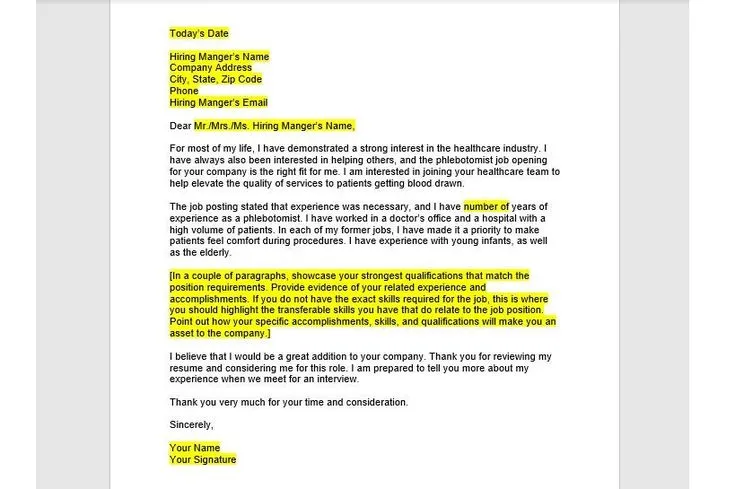Why You Need a Phlebotomist Cover Letter
In the competitive field of phlebotomy, a well-crafted cover letter can be your key to landing your dream job. It serves as your first introduction to a potential employer, providing you with an opportunity to showcase your skills, experience, and passion for the role. Unlike a resume, which provides a summary of your qualifications, a cover letter allows you to personalize your application and demonstrate why you are the perfect fit for the specific position. It’s your chance to make a compelling case and stand out from other applicants. Without a cover letter, your application may appear incomplete, potentially leading to it being overlooked. Consider it an essential tool in your job-seeking arsenal.
The Purpose of a Cover Letter
The primary purpose of a cover letter is to express your interest in a specific job and highlight how your qualifications align with the employer’s needs. It’s a marketing document, where you sell yourself by emphasizing your relevant skills and experiences. The goal is to persuade the hiring manager to read your resume and invite you for an interview. A cover letter is also an opportunity to demonstrate your communication skills, professionalism, and attention to detail. By effectively communicating your value proposition, you increase your chances of securing an interview and ultimately, the job. It helps you to paint a picture of your personality and enthusiasm for the position.
Key Components of a Phlebotomist Cover Letter
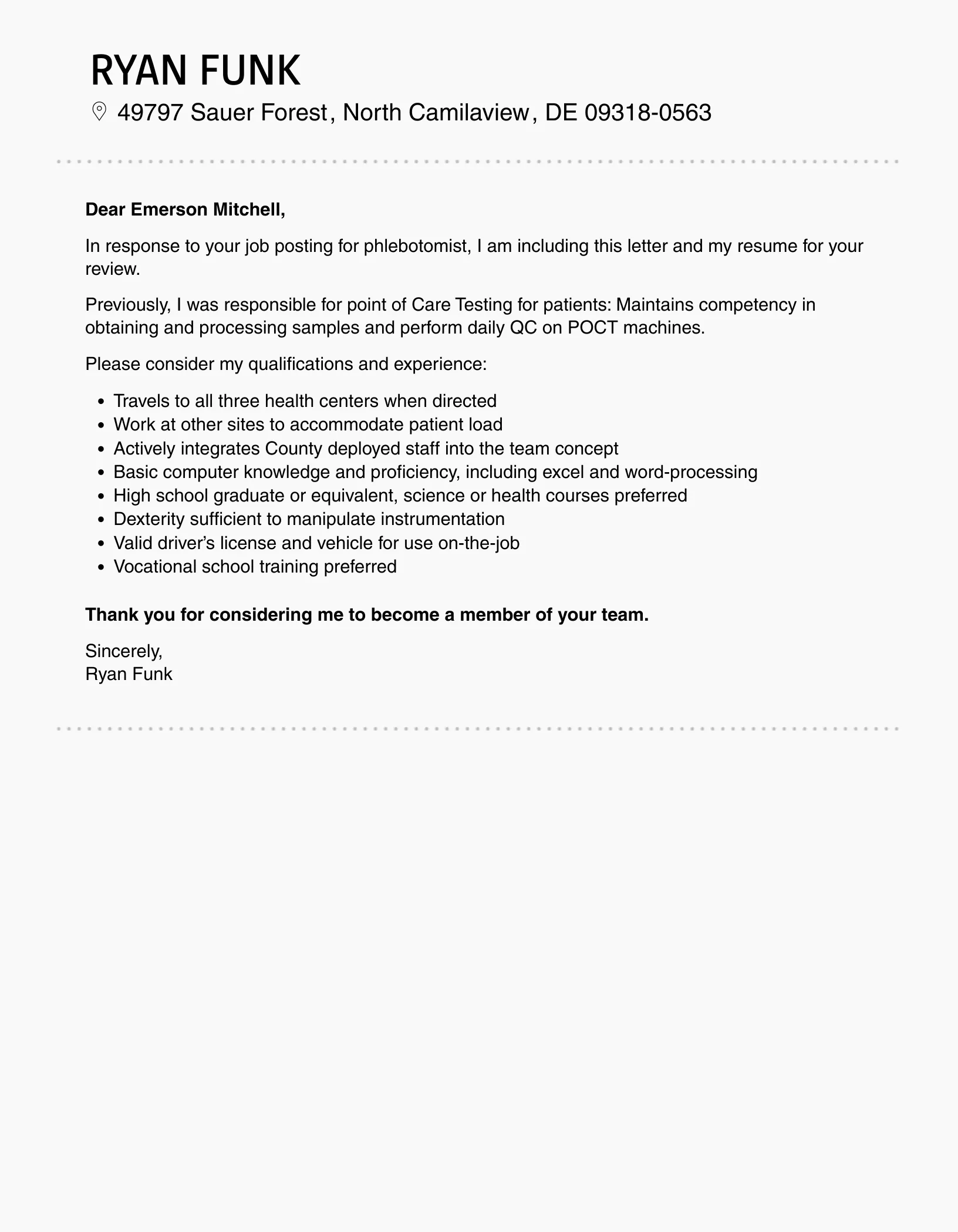
A successful phlebotomist cover letter includes several essential components. These elements work together to create a persuasive narrative and convince the employer of your suitability. Each section should be carefully considered and crafted to make a positive impression. By paying attention to detail and ensuring all elements are present, you significantly improve your chances of securing an interview. Let’s delve into each component and understand its importance.
Contact Information and Date
Begin your cover letter with your contact information at the top, including your name, address, phone number, and email address. This ensures the employer knows how to reach you. Below your information, include the date of the letter. Following this, add the recipient’s contact information (name, title, company, and address) if available. Accurate contact details are crucial for quick and easy communication if the employer decides to move forward with your application. This provides a professional appearance and makes it easy for them to follow up.
Greeting and Opening
Start your cover letter with a professional greeting. ‘Dear Mr./Ms./Mx. [Last Name]’ is ideal if you know the hiring manager’s name. If not, ‘Dear Hiring Manager’ is an acceptable alternative. Your opening paragraph should immediately grab the reader’s attention. State the position you are applying for and where you found the job posting. Briefly mention why you are interested in the role and the company. Show your enthusiasm and provide a glimpse of your key qualifications. This initial paragraph sets the tone for the rest of your letter and encourages the reader to continue.
Highlighting Your Phlebotomy Skills
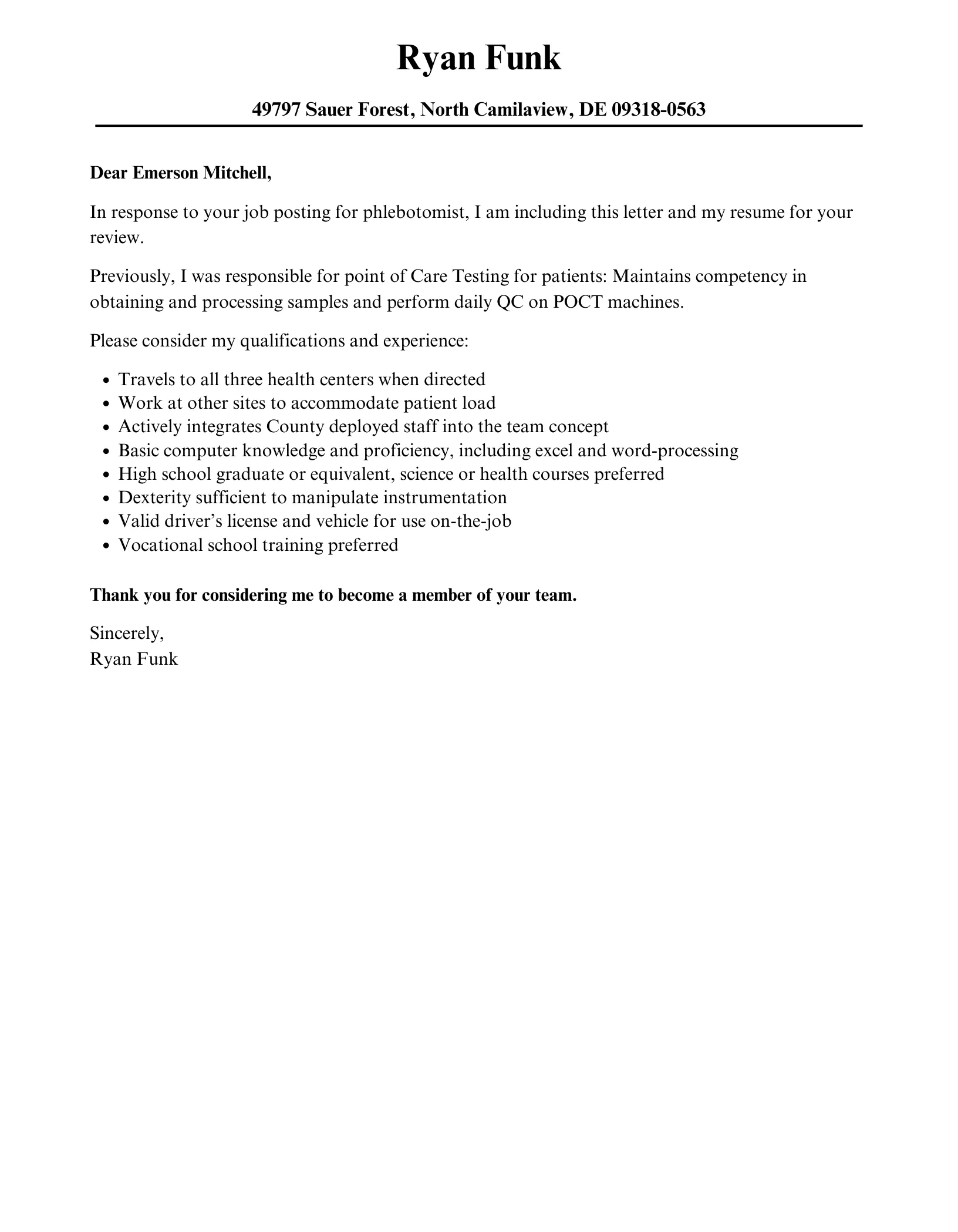
The body of your cover letter is where you highlight your phlebotomy skills. Focus on the skills most relevant to the job description. Mention your experience in venipuncture, capillary punctures, and other collection techniques. Describe your ability to work with patients of all ages and backgrounds. Emphasize your proficiency in maintaining patient comfort and safety, following proper infection control protocols, and accurately labeling and processing specimens. Give specific examples of situations where you successfully demonstrated these skills to showcase your capabilities. This section should be tailored to the specific requirements outlined in the job posting.
Mention Certifications and Licenses
Always include your phlebotomy certifications and licenses. This is a crucial element of your application. List the certifications you hold, such as the Certified Phlebotomy Technician (CPT) or other relevant credentials. Specify the issuing organization and the date of your certification. If you have any additional relevant licenses or training, mention them here. Ensure that all certifications are current and valid. This validates your professional standing and proves your commitment to the field, often making the difference in securing a job offer.
Showcasing Relevant Experience
Detail your phlebotomy experience, including previous employers and the duration of your employment. Describe your responsibilities and accomplishments in each role. Highlight your experience in various healthcare settings, such as hospitals, clinics, or laboratories. Use action verbs to describe your duties, such as ‘performed venipunctures,’ ‘collected blood samples,’ and ‘maintained patient records.’ When possible, provide specific examples of how you contributed to a positive patient experience or improved efficiency. Demonstrating a track record of success can set you apart from other candidates. Provide specific examples of your experiences.
Quantifying Achievements and Skills
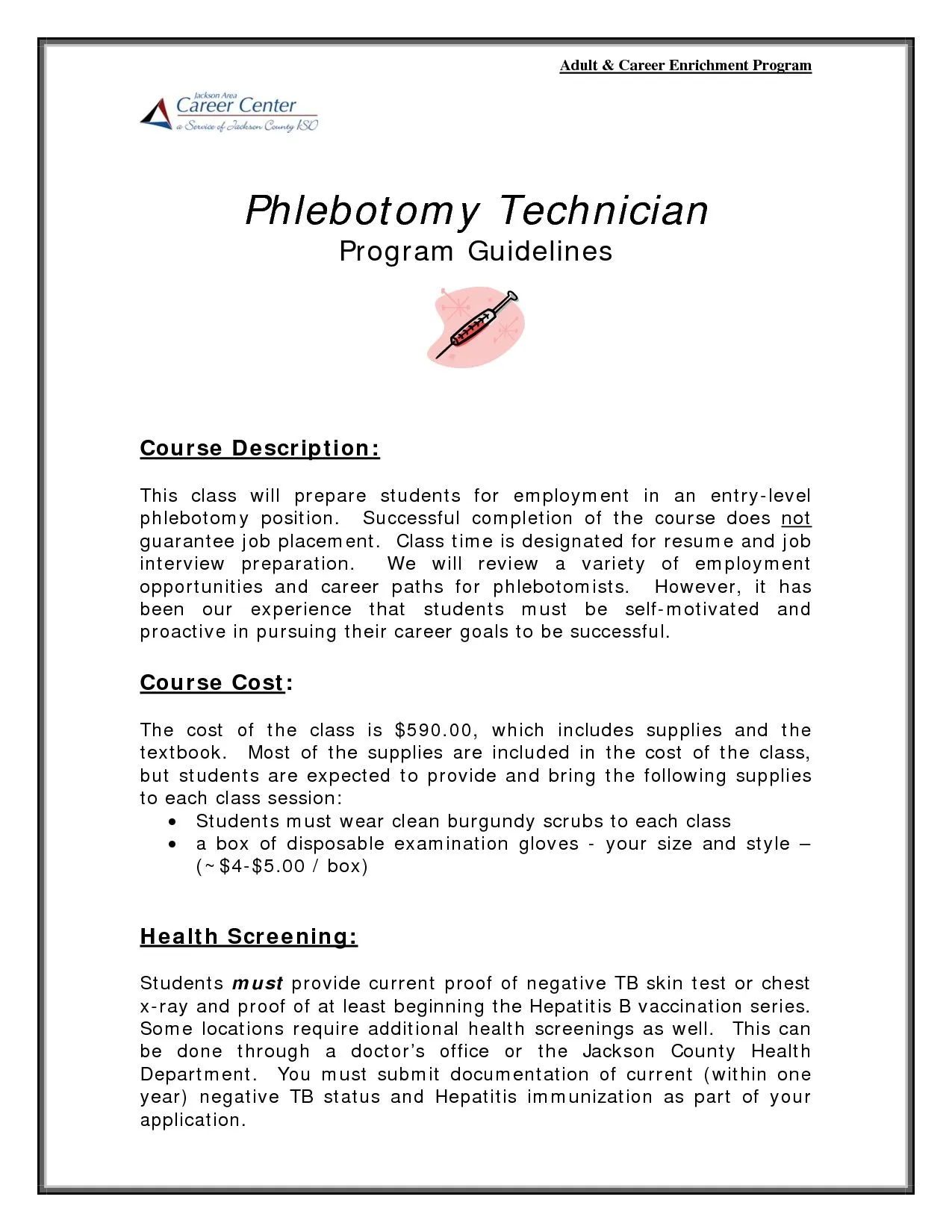
Whenever possible, quantify your achievements. Instead of saying ’efficiently collected blood samples,’ state ‘collected an average of 40 blood samples per day with a 99% accuracy rate.’ Use numbers and statistics to demonstrate your effectiveness and the impact you’ve had in previous roles. For example, you could mention the number of patients you’ve served, the percentage of successful draws, or any improvements you made to workflow or patient satisfaction. Providing specific, measurable results adds significant value to your application. This gives tangible evidence of your abilities and allows the employer to see the results of your work.
Demonstrating Your Passion for Phlebotomy
Express your enthusiasm for phlebotomy. Explain what attracts you to this profession and why you are passionate about providing quality patient care. Mention your commitment to patient comfort, accuracy, and safety. Discuss your understanding of the importance of phlebotomy in diagnosing and treating medical conditions. This demonstration can include your commitment to staying updated on the latest developments in phlebotomy and your dedication to providing excellent patient care. This genuine interest in phlebotomy can leave a lasting impression. This helps the hiring manager understand your commitment.
Closing Your Cover Letter
In your closing paragraph, summarize your key qualifications and reiterate your interest in the position. Thank the employer for considering your application. Include a call to action, such as ‘I am eager to learn more about this opportunity and discuss how my skills and experience can benefit your team.’ Keep the tone professional and enthusiastic. End with a formal closing, such as ‘Sincerely’ or ‘Best regards,’ followed by your name and signature (if submitting a hard copy).
Expressing Gratitude and Next Steps
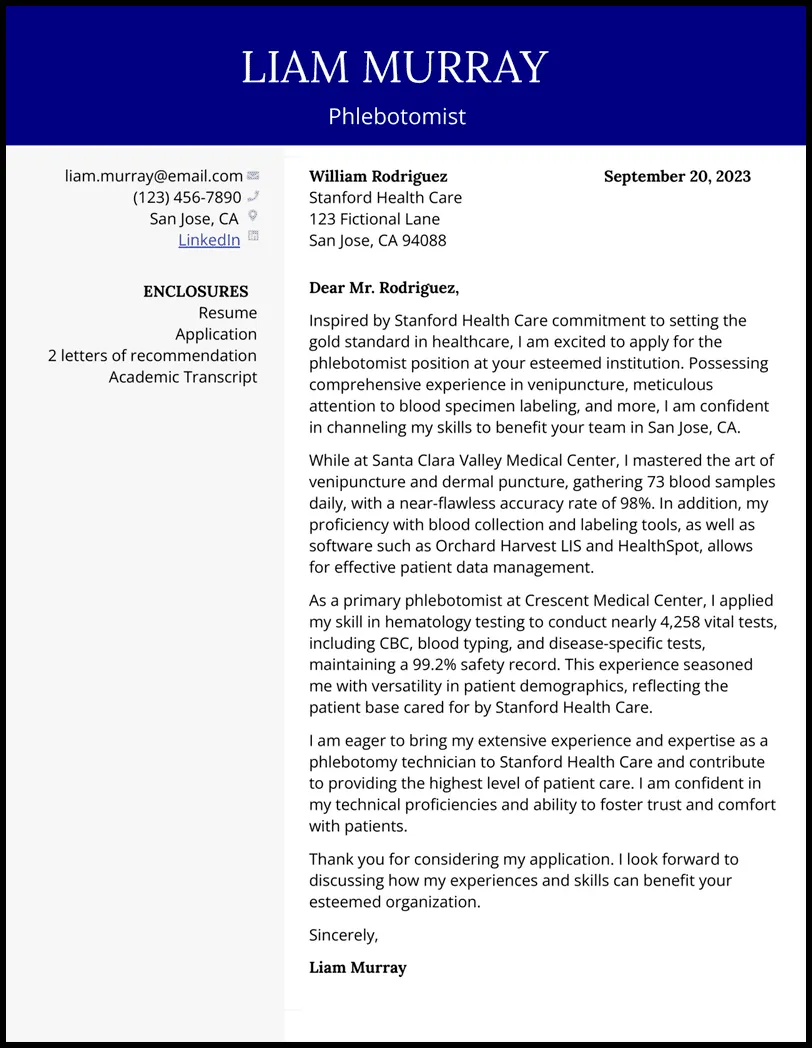
Express your appreciation for the employer’s time and consideration. Reiterate your interest in the position and mention your availability for an interview. Provide your contact information again to make it easy for the hiring manager to reach you. You might include a statement like ‘I look forward to the opportunity to speak with you and further discuss my qualifications.’ This demonstrates your proactive approach and eagerness to advance in the hiring process. Always express gratitude, it is a fundamental aspect of professionalism.
Formatting and Proofreading Your Cover Letter
The presentation of your cover letter is as important as its content. Proper formatting and proofreading ensure that your letter is easy to read and free of errors. This demonstrates your attention to detail and professionalism. A well-formatted and error-free cover letter significantly enhances your chances of making a positive impression. Careful formatting and proofreading can demonstrate how dedicated you are to the job and how much you care about the details. It is a reflection of your communication skills.
Formatting Tips
Use a professional font, such as Times New Roman, Arial, or Calibri, in a readable size (11 or 12 points). Ensure consistent formatting throughout the document, including font, spacing, and margins. Use single spacing within paragraphs and double spacing between paragraphs. Left-align your text and avoid using excessive bolding or underlining. Keep your cover letter concise, ideally within one page. Use clear headings and bullet points to organize information and improve readability. Following these formatting guidelines creates a professional appearance that can impress the hiring manager.
Proofreading and Editing
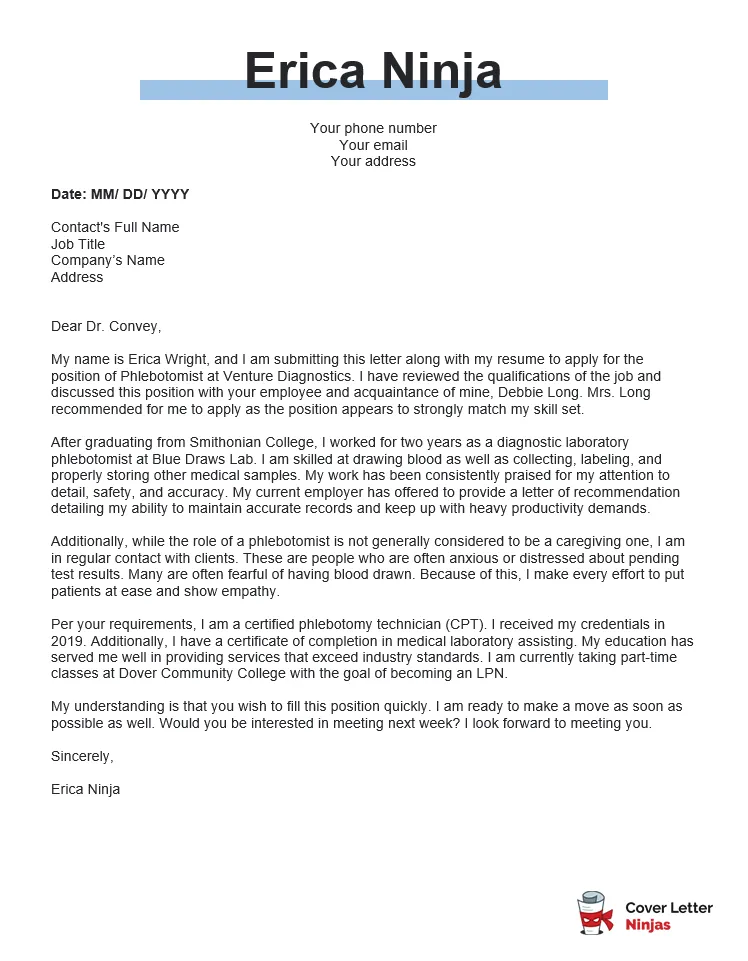
Proofread your cover letter meticulously for any grammatical errors, spelling mistakes, and typos. Read your letter aloud to catch any awkward phrasing or sentence structure issues. Ask a friend or family member to review your cover letter for a fresh perspective. Use a grammar checker tool, but don’t rely solely on it. Ensure that the tone of your letter is professional and enthusiastic. Proofreading and editing are critical to eliminating errors and ensuring the best impression. A polished cover letter shows that you care about presenting yourself well.
Common Mistakes to Avoid in Your Cover Letter
Several common mistakes can undermine the effectiveness of your phlebotomist cover letter. Avoid these pitfalls to increase your chances of success. Addressing these common errors will help you create a more impactful letter and increase your chances of landing an interview. Paying attention to these details will create a much stronger application and improve your odds.
Generic Cover Letters
Avoid using a generic cover letter that is not tailored to the specific job and company. Generic letters can make you look like you are not genuinely interested in the position. Research the company and the job requirements. Customize your letter to highlight the skills and experiences that align with the specific needs of the employer. Demonstrate that you’ve done your homework and are specifically interested in their organization. A customized cover letter shows that you are dedicated to the process and the job.
Typos and Grammatical Errors
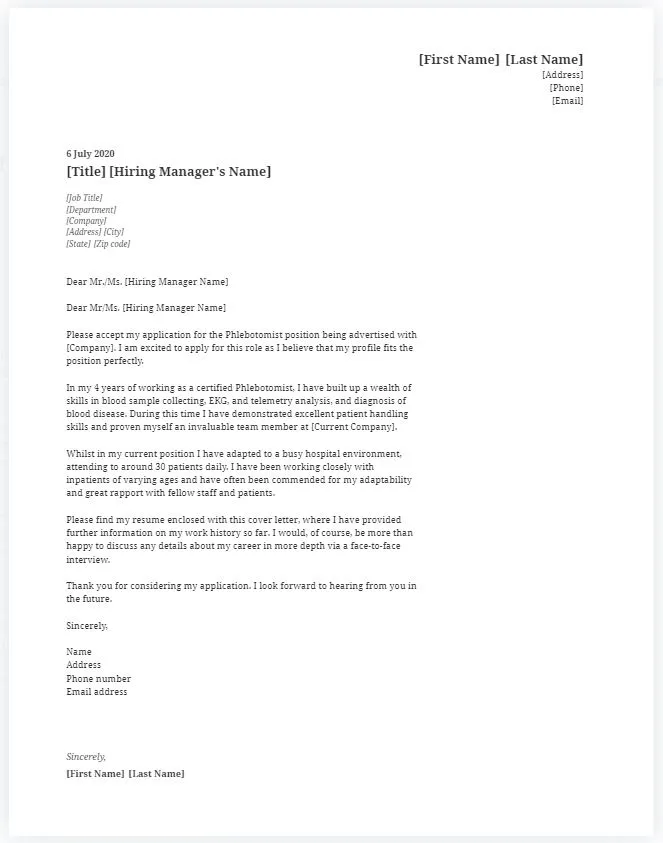
Typos and grammatical errors can damage your credibility and make you appear unprofessional. Proofread your cover letter multiple times to catch any mistakes. Use a grammar checker tool, but also have someone else review it. These errors signal a lack of attention to detail and can lead to immediate rejection. Make sure everything is perfect, as these errors are often the first things a hiring manager notices. Pay special attention to details.
Lack of Personalization
Don’t rely on a template without adding your personal touch. While a template is a good starting point, you need to tailor the content to reflect your skills, experiences, and the specific job requirements. Personalize your letter by mentioning the company’s mission, values, or recent achievements. Use a warm and professional tone that reflects your unique personality. Show that you are a real person with genuine enthusiasm for the role. Including this makes your application more interesting and effective.
Tailoring Your Cover Letter to the Job
Customizing your cover letter to each job application is essential. A generic cover letter is easily recognizable and does not demonstrate a genuine interest in the specific position. Tailoring your cover letter ensures that you highlight the skills and experiences that are most relevant to the employer’s needs. This targeted approach can increase your chances of getting noticed and securing an interview. Showing you have taken the time to understand the job requirements makes a significant difference.
Researching the Company
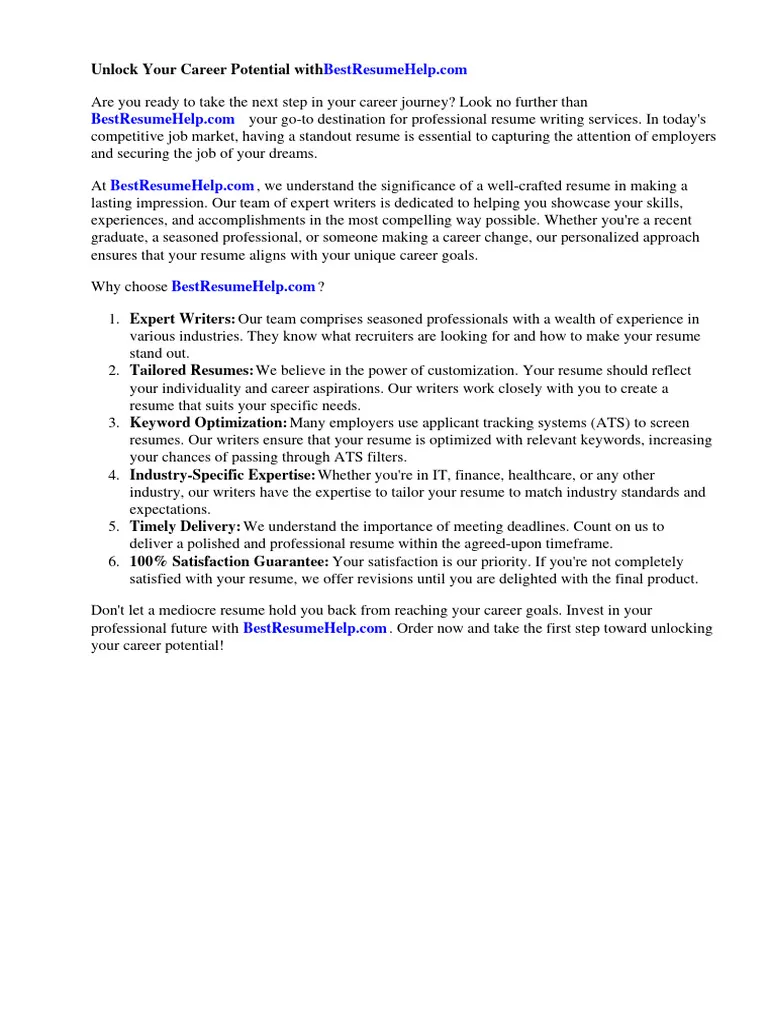
Before writing your cover letter, research the company. Visit their website to learn about their mission, values, and recent news. Understand their services and the patients they serve. Identify any specific needs or initiatives mentioned in the job description. Mentioning these in your cover letter demonstrates your interest and shows that you have gone the extra mile. This also enables you to personalize your letter, making it more relevant and appealing to the hiring manager. Knowing the company is essential to providing a tailored response.
Matching Skills to Job Requirements
Carefully review the job description and identify the key skills and qualifications the employer is seeking. Highlight your relevant skills and experiences and provide specific examples of how you have demonstrated these skills in the past. Use keywords from the job description in your cover letter to ensure your application is easily searchable by applicant tracking systems (ATS). Tailor your examples to match the specific requirements outlined in the job posting. Emphasizing relevant skills makes it clear why you are a good fit for the position.
Example Phlebotomist Cover Letter Template
Here is a basic template to get you started, remember to modify it to suit your needs. This template is meant to provide a solid structure. Customize this template with your specific details and experiences. This adaptability ensures that your cover letter is unique and effectively tailored to each job application.
Template Structure and Elements
Follow a standard structure with a clear layout. Your name, address, phone, and email go at the top. Include the date and the recipient’s contact information (if known). Start with a professional greeting (Dear Hiring Manager). The opening paragraph should state the position and your interest. The body paragraphs should detail your skills and experiences, highlighting certifications and achievements. Your closing paragraph should summarize your interest and include a call to action. End with a professional closing (Sincerely) and your name.
Modifying the Template for Your Application
Customize the template with your personal information and job-specific details. Tailor the content to highlight your most relevant skills and experiences. Mention specific achievements and quantifiable results. Research the company and incorporate details that show your interest. Proofread the modified template carefully before submitting your application. Make sure everything is relevant and tailored to the job at hand. This modification increases the chances of receiving an interview.
